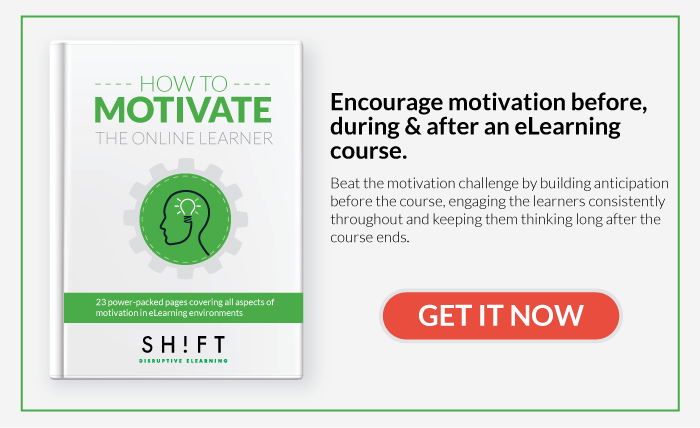A fat paycheck? Yes, but not always.
The corner office within the next five years? Yes sure, but what about now?
401(k) plan. Health and dental insurance. Paid vacation. Well, these would be nice.
What do you think is the single biggest factor that motivates employees to work at a company? According to Bersin by Deloitte’s research with Glassdoor, learning, and career opportunities are mentioned as the highest priorities by employees.
Employees know that in an ever-changing and volatile workplace, there is only ONE way to make oneself indispensable. Keep growing. Keep learning. Innovate consistently.
Companies like Yahoo, BlackBerry, and Blockbuster failed to keep up with the times. The result: they continued to lag till the day when they were forced to give up.
Innovation is the game-changer. It is true not only for organizations but also for individuals. This is why companies are able to lure valuable employees away from their rivals with the promise of training opportunities.
As an HR or training professional, you have to keep your employees engaged in working for the company by providing them with ample learning opportunities. They need to improve their skills, increase productivity, and be on top of their game, so your business can out-innovate its rivals, tide over disruptions, and respond to market changes.
Here are three ideas on how your company can turn employees into lifelong learners:
1) Provide Employees with Easy Access to Asynchronous Learning
One of the biggest mistakes companies make is to assume that employees don’t need to repeat what they have learned. Organizations often take away access to online training courses after rolling these out once.
But employees may want to revisit these courses at will. Some of them may not get a chance to apply the learning just after they take the course; they would want to retake the assessment module or go through a simulation activity to keep up the practice.
Organizations MUST ensure that they provide employees easy access to asynchronous learning. Here are the benefits for employees:
- Take or re-take any course at their own time, place, and convenience. Busy corporate learners don’t like to be whisked off from their desks to attend training sessions. An online learning platform that provides easy access to asynchronous learning lets employees keeps up with training without needing to disrupt work or upset schedules. They can take a course on their home machine during the weekend or skim over it on their tablets or smartphones during the commute to work.
- Learn at their own pace. Without classroom training sessions to attend and with the knowledge that the courses will always be available on the online training platform, employees have the convenience and luxury of learning at a pace that suits them the most. This makes the learning experience favorable and one that they can look forward to.
- No need to wait for the company to organize a training session to learn a new skill. Employees should keep up with new skills and knowledge at their own time and pace.
- Retake courses periodically to reinforce learning. Repetition reinforces learning. When the learning modules are easily available on the online training platform, employees can go through a course as often as they feel the need for it.
And what's in it for companies? They are spared the expense and hassle of organizing classroom training sessions. Companies with products that undergo frequent upgrades are spared the expense and hassle of organizing classroom training sessions, paying for the time of subject matter experts, and tweaking the schedules of employees from various departments to accommodate the sessions.
- Continuous Learning Learning Is Not a One-Time Event!
- 3 Keys to Embracing a Culture of Self-Directed Learning in the Workplace
2) Embed Learning in the Flow Of Work
Do cooks learn only from books and TV shows? No, they learn best when they actually cook and apply what they learned from books and shows.
As they cook, they learn to play around with ingredients and come up with quirky tastes and innovative combinations. They learn to make do and still come up with finger-licking good food when ingredients are scarce. They learn to create recipes.
Nothing reinforces learning more than application. It is when they put learning into practice that people learn to interpret facts and definitions in context, synthesize learning with experiences, and figure out troubleshooting tips and tricks.
But there cannot be too much lag between learning and application; else employees will forget crucial pieces of information. The best training happens when “learning is the work,” according to Harold Jarche.
Here are some compelling statistics:
- Millennials are 14% more likely to find learning on the job more effective than attending traditional classes where they rote learn and are never certain when they will be able to apply what they have learned.
- According to Learning & Development Roundtable, on-the-job training has three times more favorable impacts than classroom training.
- Employees who learn on the job exhibit 262 percent more engagement than those who learn in classrooms and away from work.
L&D expert Charles Jennings calls this also “Embedded Learning” and he considers it the best training strategy. It puts learning closer to the context and establishes relevance.
Your employees are familiar with Netflix. They look up natural remedies and DIY fixes on Pinterest or their favorite blogs. They make travel plans at Airbnb. They take an Uber to the office. So it is natural that they feel most comfortable wielding technology to meet their training needs.
Here are some ways in which you can use technology to integrate learning into your everyday workflow:
- Online social media platforms where employees can share tips and experiences and find answers to their questions
- A central online repository with sophisticated search features that houses all the training modules that employees may need to address knowledge gaps
- Videos and podcasts to upload procedure demos and share best practices
- Wikis, forums, blogs, and chat groups that let employees build their own knowledge base
- Mobile learning modules that deliver knowledge on the go
- Easy online access to subject matter experts
- Webinars to spread knowledge
- On-demand online help desks
3) Create Collaborative/Social Learning Opportunities
According to a Deloitte report, about 80 percent of learning on the job occurs through interactions with co-workers. But it is only recently that peer-to-peer learning has come to be recognized as an effective training strategy.
It is not for nothing that Google has created a peer-to-peer training culture where about 55 percent of the company’s L&D needs are met by a network of over 2,000 peer learners.
Here’s why peer-to-peer learning is gaining acceptance in companies across the world:
- A culture of peer-to-peer learning creates a sustainable learning environment where employees do not have to wait around for the C-suite or training manager to gauge their needs and roll out courses.
- Peer-to-peer training does away with the need to organize classroom training sessions and book the time of subject matter experts. It is an efficient and cost-effective way of imparting training.
- Peer-to-peer learning meets the demands of a dynamic workplace where there is now a greater need for easily accessible (read: on-demand) and more frequent training.
As an HR manager, facilitate peer-to-peer learning through:
- Encouraging and helping departments create their own training materials and share these, for example, in an internal Wiki.
- Inspiring and supporting teams to curate relevant external learning resources and share these.
- Creating an online social platform where employees can interact and share experiences and knowledge while at their job.
Also read: How To Adapt & Evolve Your eLearning Courses For for Modern Learners
As an HR or training professional, it is your job to bring out the best in your employees. Adult learners are sensible people; they realize and appreciate it when they are valued. Creating a vibrant and sustainable learning environment in your organization helps employees keep up-to-date on relevant skills. When you show them that you have their best interests in mind, your employees reciprocate by sticking around and giving their best at the workplace.
REFERENCES:
Workplace Learning: Adding, Embedding & Extracting http://charles-jennings.blogspot.com/2013/10/workplace-learning-adding-embedding.html
Embedding Learning in the Flow of Work http://www.slideshare.net/janehart/embedding-learning-in-the-flow-of-work/30-wwwC4LPTcouk_The_Social_Learning_Revoluon
The power of peer-to-peer learning https://www.learnevents.com/blog/2015/07/10/the-power-of-peer-to-peer-learning/
The Top 10 Benefits Of Ongoing Staff Training And Development http://www.saxonsgroup.com.au/blog/human-resources/top-10-benefits-of-ongoing-staff-training-development/
To Stay Relevant, Your Company and Employees Must Keep Learning https://hbr.org/2016/03/to-stay-relevant-your-company-and-employees-must-keep-learning
5 practical ideas for Embedding learning into the workflow http://towardsmaturity.org/shop/wp-content/uploads/2013/07/In-focus-Embedding-learning-into-the-workflow-1.pdf
Six Ways to Improve Millennial Employee Learning https://www.cebglobal.com/blogs/six-quick-wins-for-improving-millennial-employee-learning/



